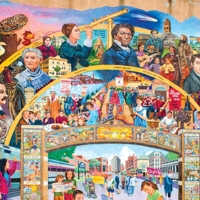
Central Square Mural
In 2015, muralists David Fichter, Yetti Frenkel and Joshua Winer created a 17-foot, 3 storey mural titled Central Square Mural in the city of Lynn, Massachusetts. With input from local residents and schoolchildren, the muralists created a historic panoramic at 25 Exchange Street. Assembled in two phases, the first phase entailed artists working with students from Lynn Middle and High schools to create a mosaic arch about contemporary life in Lynn. The second phase focused on the history of the city. This section depicts the shoe industries of the 19th century, labor unrest, burning factories, Hiram Marble digging for buried treasure in Lynn Woods’ Dungeon Rock, astronomer Maria Mitchell, poet Vincent Ferrini, and, assuming a central position in the mural, the abolitionist Frederick Douglass.The mural was funded by the New England Foundation for the Arts and the Massachusetts Cultural Council.
![John Weber, Wall of Choices, Christopher Settlement House, N Greenview Ave and W Altgeld St, Chicago 1970 [destroyed], detail.jpg John Weber, Wall of Choices, Christopher Settlement House, N Greenview Ave and W Altgeld St, Chicago 1970 [destroyed], detail.jpg](https://486312.frmmmguz.asia/files/square_thumbnails/9fc1c6430ac66c245ed40da9a8d9ad6c.jpg)
Wall of Choices
In 1970, John Pitman Weber of the Chicago Public Art Group created a mural on the wall of the Christopher Settlement House on the north side of Chicago. The mural faces a children’s playground in a predominantly white working-class area of the city and according to Weber, the neighbourhood’s anxiety regarding racial tensions in the community only emerged during the creation of the mural and related discussions with local residents. Working together, Weber and the local residents agreed that the racial concerns needed to be surfaced, and the mural would serve this purpose. It depicts narrative scenes across the wall, including daggers and guns held by both black and white individuals, black hands in handcuffs under the phrase “free all political prisoners,” (something that the Black Panther Party was pushing for in the 1960s and 1970s), and a black hand shaking a white hand under the faces of Frederick Douglass and the radical white abolitionist John Brown, who are both identified on the mural as Freedom Fighters. The mural had been destroyed by the late 20th century.
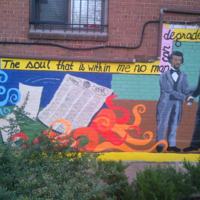
Frederick Douglass Recreation Center Mural
Painted in 2012 by MTC Studio, the mural depicts the black abolitionist Frederick Douglass shaking hands with President Abraham Lincoln. An older version of Douglass is offset to the right side of the mural. The mural site is adjacent to the Frederick Douglass National Historic Site in Anacostia, Washington D.C.
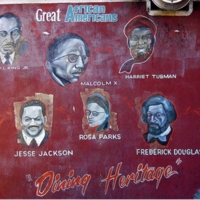
Great African Americans
An unknown artist painted this mural in Harlem, New York City, on the facade of Dining Heritage. It depicts the abolitionists Frederick Douglass and Harriet Tubman, as well as Martin Luther King Jr., Rosa Parks, Jesse Jackson and Malcolm X. It was destroyed in 2015.
![Don Rodgers, Our Brothers and Sisters, 100th and Halsted Streets [Black Neighborhood], Chicago, 1984.jpg Don Rodgers, Our Brothers and Sisters, 100th and Halsted Streets [Black Neighborhood], Chicago, 1984.jpg](https://486312.frmmmguz.asia/files/square_thumbnails/ade8cb4554aca77fae33825bf55434dc.jpg)
Our Brothers and Sisters
Titled Our Brothers and Sisters, this mural depicts figures of black history, including the abolitionist Frederick Douglass and also Harold Washington, Martin Luther King Jr., Booker T. Washington, Malcolm X, W.E.B. Du Bois, and Louis Armstrong.
![G. Byron Peck, Frederick Douglass, 12th St at Massachusetts Ave NW, Washington DC, 1995 [destroyed 2002].jpg G. Byron Peck, Frederick Douglass, 12th St at Massachusetts Ave NW, Washington DC, 1995 [destroyed 2002].jpg](https://486312.frmmmguz.asia/files/square_thumbnails/a53a1bcc780d8242cfbd11faab4c24e5.jpg)
Frederick Douglass
G. Byron Peck created this mural in Washington D.C. on the side of a boutique hotel called the Swiss Inn. In 2002, the mural was lost from public view when a luxury apartment complex was built next door, against the mural wall. The image depicts multiple stages of Frederick Douglass’ life against the backdrop of the American flag. In the 1990s, Peck became well-known in Washington D.C. after covering more than 300,000 square feet of the city's walls with his murals. Peck is now the founder, artistic firector and lead artist for all City Arts murals in the D.C. area.
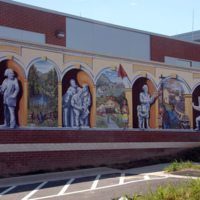
Paradise
In 2010, muralist Michael Kirby created a Maryland mural titled Paradise that depicts scenes of American progress. It includes the abolitionist Frederick Douglass and other historical figures.
![K. Fitch, Frederick Douglass Mural, Main, West and Chili Avenues, Rochester, New York, 2008 [destroyed].jpg K. Fitch, Frederick Douglass Mural, Main, West and Chili Avenues, Rochester, New York, 2008 [destroyed].jpg](https://486312.frmmmguz.asia/files/square_thumbnails/77bb817c2a6e0bd9f38a07546c281959.jpg)
Frederick Douglass
In 2008, muralist K. Fitch painted a mural of Frederick Douglass in the abolitionist's former home town of Rochester, New York. The mural depicts Douglass in the later years of his life. It had been destoyed by 2014.
![Eugene 'Edaw' Wade, Cramton Auditorium Mural, Howard University, 1976 [destroyed].jpg Eugene 'Edaw' Wade, Cramton Auditorium Mural, Howard University, 1976 [destroyed].jpg](https://486312.frmmmguz.asia/files/square_thumbnails/9b88d25ab0cf2bbdaa447fb07c56eee8.jpg)
Cramton Auditorium Mural
In 1976, Eugene Eda Wade created a mural at Howard University in Washington D.C. The mural depicts the abolitionists Sojourner Truth and Nathaniel Turner attempting to break chains, as well as the abolitionists Frederick Douglass and Harriet Tubman, and leaders Malcolm X and Martin Luther King Jr. The mural has now been destroyed.
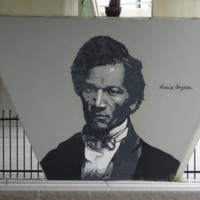
Historic Rochester Mural
In 2014, Rochester's Shawn Dunwoody created a mural on the Interstate 490 bridge over West Main Street. It depicts the abolitionist Frederick Douglass, as well as Susan B. Anthony, Nathaniel Rochester and Austin Steward - all famous Rochester figures
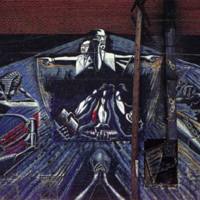
Wall of Meditation
In 1970, Eugene Eda Wade painted the Wall of Meditation on the exterior façade of the Olivet Community Center. Malcolm X and Martin Luther King Jr. anchor the middle of the mural, and are surrounded by Egyptian figures on the left, and enslaved figures breaking free from their chains on the right.
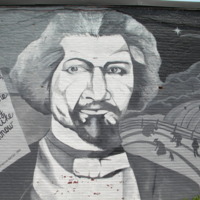
Frederick Douglass
In 1860, Frederick Douglass took to the stage at Boston's African Meeting House to give his speech, “A Plea for Free Speech in Boston.” Muralists Deborah Browder and Heidi Schork transcribed words from the speech onto their mural at Hammond and Tremont Street. “Liberty is meaningless when the right to utter one’s thoughts and opinions has ceased to exist,” Douglass pronounced in 1860. Three years later, in the same Meeting House on Joy Street, Beacon Hill, African American soldiers, including two of Douglass’ sons, were recruited into the Fifty-fourth Regiment of the Massachusetts Infantry under the leadership of Colonel Robert Gould Shaw.
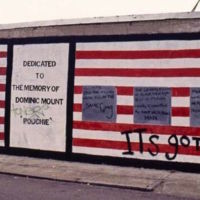
All in the Same Gang
In 1998, at the height of gang related murders in the city of Boston, Jameel Parker was commissioned to paint a mural by Gang Peace, a not-for-profit, street-based programme seeking to reduce the number of murders in Boston by redirecting youths into education and career-oriented activities. In 1992, around 600 local youths between the ages of 8 and 23 participated in Gang Peace programmes. Parker’s mural, titled All in the Same Gang, was painted in Boston and became a monument to those who had died as a result of gang crime. During its creation, on the corner of the street where the mural was painted – Blue Hill Avenue and Floyd Street – a young boy named Dominic Mount was murdered. Given the immediate community outcry following his death, Parker dedicated the mural to Mount and placed his name alongside heroes of Black history; Frederick Douglass, W.E.B. Du Bois, Malcolm X and Elijah Muhammad. By 2016, the portraits of the African American male leaders had faded and the mural had changed to now include four black women, includng abolitionist Harriet Tubman.